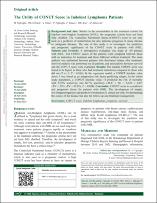The Utility of CONUT Score in Indolent Lymphoma Patients

View/
Access
info:eu-repo/semantics/openAccessDate
2023Author
Tığlıoğlu, MesutAfacan Öztürk, Hacer Berna
Yıldız, Abdulkerim
Tığlıoğlu, Pınar
Yılmaz, Fatma
Aras, Merih Reis
Albayrak, Meryem
Metadata
Show full item recordCitation
Tighoglu, M., Ozturk, H. B. A., Yildiz, A., Tighoglu, P., Yilmaz, F., Aras, M. R., & Albayrak, M. (2023). The Utility of CONUT Score in Indolent Lymphoma Patients. Nigerian Journal of Clinical Practice, 26(9), 1290-1296.Abstract
Background and Aim: Similar to the uncertainties in the treatment criteria for indolent non-Hodgkin lymphoma (iNHL), the prognostic criteria have not been fully clarified. The Controlled Nutritional Status (CONUT) score is not only used as a predictor of malnutrition but also indicates prognosis in many chronic or malignant diseases. The aim of this study is to investigate the predictive and prognostic significance of the CONUT score in patients with iNHL. Patients and Methods: A retrospective evaluation was made of 109 patients with iNHL. The CONUT scores of the patients were compared between those with an indication for treatment and those followed without treatment. The same analysis was performed between patients who developed relapse after treatment. Survival analysis was performed on all patients, and associations between survival and the CONUT score were examined. Results: The median CONUT score was found to be higher in those who had treatment indications compared to those who did not (2 vs 1; P = 0.014). In the regression model, a CONUT absolute value above 5 was found as an independent risk factor predicting relapse. In the whole study population, a CONUT absolute value >2 predicted the risk of mortality with 53.9% sensitivity and 68.7% specificity (AUC ± SE = 0.639 ± 0.07; +PV = 35%; -PV = 82.6%; P = 0.034). Conclusion: CONUT score is a predictive and prognostic factor for patients with iNHL. The development of simple, low-budget prognostic and predictive biomarkers is critical not only for determining the course of the disease but also for follow-up and treatment management.

















